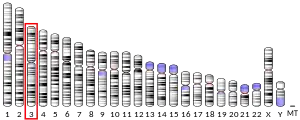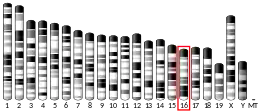EPHA6
Ephrin type-A receptor 6 is a protein that in humans is encoded by the EPHA6 gene.[5][6]
EphA6 may serve an important role in breast carcinogenesis and may pose as a novel prognostic indicator and therapeutic target for breast cancer, particularly in patients with steroid receptor negative expression and HER‑2 overexpression[7]
References
- GRCh38: Ensembl release 89: ENSG00000080224 - Ensembl, May 2017
- GRCm38: Ensembl release 89: ENSMUSG00000055540 - Ensembl, May 2017
- "Human PubMed Reference:". National Center for Biotechnology Information, U.S. National Library of Medicine.
- "Mouse PubMed Reference:". National Center for Biotechnology Information, U.S. National Library of Medicine.
- Manning G, Whyte DB, Martinez R, Hunter T, Sudarsanam S (December 2002). "The protein kinase complement of the human genome". Science. 298 (5600): 1912–34. Bibcode:2002Sci...298.1912M. doi:10.1126/science.1075762. PMID 12471243. S2CID 26554314.
- "Entrez Gene: EPHA6 EPH receptor A6".
- Zhou D, Ren K, Wang J, Ren H, Yang W, Wang W, et al. (April 2018). "Erythropoietin-producing hepatocellular A6 overexpression is a novel biomarker of poor prognosis in patients with breast cancer". Oncology Letters. 15 (4): 5257–5263. doi:10.3892/ol.2018.7919. PMC 5840743. PMID 29552165.
Further reading
- Wilkinson DG (2000). Eph receptors and ephrins: regulators of guidance and assembly. pp. 177–244. doi:10.1016/S0074-7696(00)96005-4. ISBN 9780123646002. PMID 10730216.
{{cite book}}:|journal=ignored (help) - Xu Q, Mellitzer G, Wilkinson DG (July 2000). "Roles of Eph receptors and ephrins in segmental patterning". Philosophical Transactions of the Royal Society of London. Series B, Biological Sciences. 355 (1399): 993–1002. doi:10.1098/rstb.2000.0635. PMC 1692797. PMID 11128993.
- Nakamoto T, Kain KH, Ginsberg MH (February 2004). "Neurobiology: New connections between integrins and axon guidance". Current Biology. 14 (3): R121-3. doi:10.1016/j.cub.2004.01.020. PMID 14986683. S2CID 2957639.
- Yamaguchi Y, Pasquale EB (June 2004). "Eph receptors in the adult brain". Current Opinion in Neurobiology. 14 (3): 288–96. doi:10.1016/j.conb.2004.04.003. PMID 15194108. S2CID 26196696.
- Murai KK, Pasquale EB (August 2004). "Eph receptors, ephrins, and synaptic function". The Neuroscientist. 10 (4): 304–14. doi:10.1177/1073858403262221. PMID 15271258. S2CID 23900846.
- Gale NW, Holland SJ, Valenzuela DM, Flenniken A, Pan L, Ryan TE, et al. (July 1996). "Eph receptors and ligands comprise two major specificity subclasses and are reciprocally compartmentalized during embryogenesis". Neuron. 17 (1): 9–19. doi:10.1016/S0896-6273(00)80276-7. PMID 8755474. S2CID 1075856.
- Aasheim HC, Munthe E, Funderud S, Smeland EB, Beiske K, Logtenberg T (January 2000). "A splice variant of human ephrin-A4 encodes a soluble molecule that is secreted by activated human B lymphocytes". Blood. 95 (1): 221–30. doi:10.1182/blood.V95.1.221. PMID 10607706.
- Prevost N, Woulfe D, Tanaka T, Brass LF (July 2002). "Interactions between Eph kinases and ephrins provide a mechanism to support platelet aggregation once cell-to-cell contact has occurred". Proceedings of the National Academy of Sciences of the United States of America. 99 (14): 9219–24. Bibcode:2002PNAS...99.9219P. doi:10.1073/pnas.142053899. PMC 123121. PMID 12084815.
- Clark HF, Gurney AL, Abaya E, Baker K, Baldwin D, Brush J, et al. (October 2003). "The secreted protein discovery initiative (SPDI), a large-scale effort to identify novel human secreted and transmembrane proteins: a bioinformatics assessment". Genome Research. 13 (10): 2265–70. doi:10.1101/gr.1293003. PMC 403697. PMID 12975309.
- Hafner C, Schmitz G, Meyer S, Bataille F, Hau P, Langmann T, et al. (March 2004). "Differential gene expression of Eph receptors and ephrins in benign human tissues and cancers". Clinical Chemistry. 50 (3): 490–9. doi:10.1373/clinchem.2003.026849. PMID 14726470.
External links
This article is issued from Wikipedia. The text is licensed under Creative Commons - Attribution - Sharealike. Additional terms may apply for the media files.



